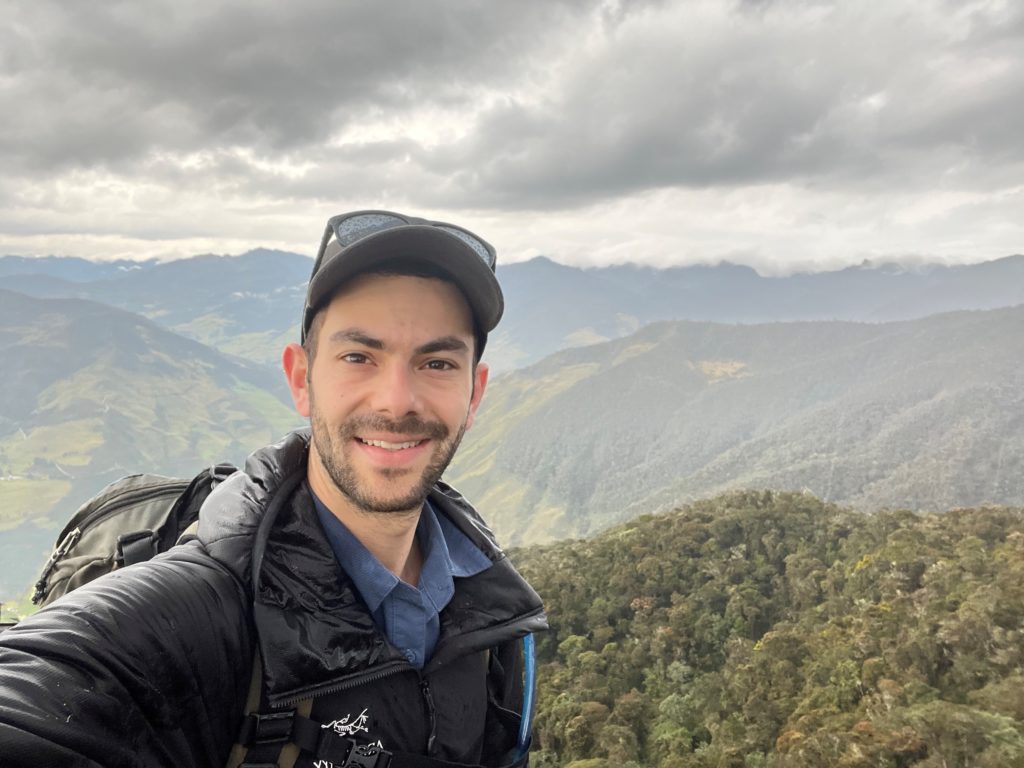Ecuador alum’s research focused on how science informs decision-making
October 26th, 2022 | SIT Study Abroad
By Gabriel Oppler
Gabriel Oppler participated in SIT Ecuador: Comparative Ecology and Conservation in 2016. Click here to find out more about this program.

In 2016, I was a junior at Haverford College majoring in biology with minors in environmental studies and Spanish. At the time, I knew these three topics could intersect in myriad ways, but only in my second semester did I see just how powerful a combination that could be.
That spring, I traveled to Ecuador on SIT’s Comparative Ecology and Conservation program. Living for several months with a wonderful host family in Quito, my Spanish skills finally leapt from academic reading and writing into full conversational proficiency. Excursions to this country’s many unique ecosystems impressed on me the importance of conserving biodiversity—flora and fauna species both known and as-of-yet undiscovered. What’s more, my Independent Study Project (ISP) in the Amazon region underscored the tensions underlying resource extraction (in this case, crude oil), traditional livelihoods, and environmental protection.
At the end of the semester, I left Ecuador with a more complete understanding of what “conservation” strives to achieve: balance between the needs of people and the needs of nature. What’s more, I had a strong sense that I would return to Ecuador. It was only a matter of time.
In the few years after graduation, I gained further experience at the intersection of society and ecology, working as a research assistant in botany and soil geochemistry, and trying my hand at environmental education. In 2019, I joined the staff at the Bozeman, Montana-based NGO Center for Large Landscape Conservation, whose mission is to advance the science, policy, and practice of connectivity conservation—an approach that prioritizes the lands between protected areas that support all ecological flows and processes.
I left Ecuador with a more complete understanding of what 'conservation' strives to achieve: balance between the needs of people and the needs of nature.
After three years away from school, I started my master’s degree at the University of Montana. Through UM’s W.A. Franke College of Forestry and Conservation, I enrolled in a unique degree offering called International Conservation and Development. The ICD program encourages graduate students to perform original research outside of the U.S. With a familiarity and appreciation for tropical conservation—stemming in large part from my experience with SIT—I began charting a return to Ecuador.
I designed a research project that focused on the newly established Sangay-Podocarpus Connectivity Corridor, a unique conservation initiative spearheaded by NGOs, universities, and the Ministry of Environment in Ecuador’s southern provinces. The corridor’s multi-scale governance model, premised on institutional collaboration, offers a potential exemplar for other parts of the world eager to implement connectivity conservation among and between existing protected areas. I was especially interested in the initiative’s capacity to use science to inform decision-making, and vice versa (how governance structures affect how science is produced).
Being immersed in this biodiversity hotspot—and getting to know the people working to protect its richness—added a level of appreciation that virtual engagement could never provide.
My approach was exploratory, conducting semi-structured interviews with key stakeholders in the region. Our interviews were virtual at first, and then, after some delay and logistical challenges posed by the COVID-19 pandemic, I finally made it back to Ecuador. Once on the ground, I could pair interviews with field visits into the páramo and cloud forest that make up the corridor. Traveling around the landscape on foot, bus, and motorcycle was irreplaceable. As had been the case during my semester with SIT, being immersed in this biodiversity hotspot—and getting to know the people working to protect its richness—added a level of appreciation that virtual engagement could never provide.
After interviews and field visits were complete, I returned to Montana to complete my thesis. Looking at my data, I realized that implementing initiatives like the Sangay-Podocarpus Connectivity Corridor depends on many kinds of capacity: a common vision and set of values among collaborators; salient and credible science; open and transparent communication; and adequate funding and human resources. While this case study is context-specific, it highlights the need for ample, targeted capacity-building resources to support and sustain connectivity conservation that achieves both social and ecological goals.
Ultimately, I hope that these findings will not only contribute to the academic literature, but also provide tangible recommendations for the corridor and other initiatives like it. It was a privilege to conduct research in Ecuador and learn from some of the most knowledgeable and passionate conservationists on the planet. And as my interest in tropical conservation continues, I remain grateful for the foundation that I built as an SIT student back in 2016.
